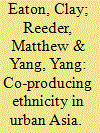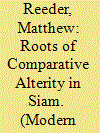|
|
|
Sort Order |
|
|
|
Items / Page
|
|
|
|
|
|
|
| Srl | Item |
| 1 |
ID:
193124


|
|
|
|
|
| Summary/Abstract |
The articles in this special issue examine engagements across ethnic boundaries in Asian cities over the past two centuries. We see these cities as stages for the co-production of ethnicity, where multiple actors, including but not limited to state authorities, have attempted to define, manage, and challenge the social boundaries between their diverse inhabitants. These articles direct our attention to the convergence of three critical themes: the flexibility and ubiquity of ethnic ascription, the top-down and bottom-up co-production of social meaning, and Asian cities as crucial sites of social innovation.
|
|
|
|
|
|
|
|
|
|
|
|
|
|
|
|
| 2 |
ID:
179403


|
|
|
|
|
| Summary/Abstract |
This article identifies a moment of conceptual innovation—the 1830s to the 1850s—in which everyday artists and writers in Siam were tasked with creating comparative representations of the peoples of the world. Although their compositions took a variety of formats, they departed from earlier representations of alterity by devoting equal attention to each ‘type’, including the Thai themselves. This approach is best exemplified in three mid-nineteenth-century works: (1) a set of archetypal portraits of about 20 peoples painted on the shutters of a major Buddhist monastery, (2) sculptures of 32 peoples at the same monastery with a short poem describing each one, and (3) entries defining terms for peoples in an early Thai–Thai dictionary. The systematic formatting of these works drew on similar compositions circulating across the nineteenth-century globe. Yet, despite the presence in Bangkok of foreign interlocutors and imported books and prints, the mid-nineteenth-century compositions preserve ethnic tropes and practices of expression specific to Siam. In addition, the agents of intellectual innovation were not restricted to the usual princely or missionary protagonists. It was a motley cast of anonymous artists, local scholars, and middling officials who tapped traditional genres of composition and local markers of differentiation to render the peoples of the world as comparable, generic, and fixed.
|
|
|
|
|
|
|
|
|
|
|
|
|
|
|
|
|
|
|
|
|